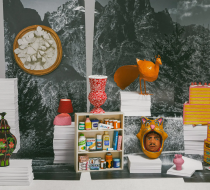How Contemporary Artists Are Taking Papier-Mâché Out of the Classroom Favorite
A new wave of self-taught craftspeople are using the medium to make playful, thought-provoking works.
The artist Joel Hernandez, 39, first worked with papier-mâché as an 8-year-old, soon after moving from Mexico to rural Indiana. His parents had gone looking for piñatas — a staple of their family celebrations — at local stores but had come up short. “So we decided to make our own,” he says. Two decades later, when Hernandez began collecting traditional tribal masks from all over the world, he says that, as a gay person, he realized, “I couldn’t see my image in masks out there.” And so, like his parents before him, he decided to take matters into his own hands. Today, he makes brightly colored, highly animated papier-mâché face coverings that he builds by layering strips of recycled newspaper dipped in a flour, water and salt paste over Plasticine forms. “The first one I made was two guys cheek to cheek,” he says of the masks, which have been shown at galleries — he had a solo show at La Luz de Jesus in Los Angeles this past fall — and are sold online.
Hernandez, now based in San Francisco, is just one of the contemporary craftspeople using papier-mâché in new and provocative ways. All are self-taught and create everything from playful reproductions of mundane household staples (such as cereal boxes and telephones) to functional décor like vases and frames. And while each has a different approach to the medium, they share an appreciation for its democratic and economic nature. Making papier-mâché, after all, requires nothing more than a few pantry items, some trash and a bit of imagination.
French for “chewed paper,” papier-mâché has gone by many names in many cultures dating back to the advent of papermaking in China in A.D. 200, when mulberry pulp and paste were molded to create helmets for Han dynasty warriors. Since then, the lightweight but surprisingly strong composite has been used to make everything from Egyptian death masks and 19th-century French baby doll heads to American crew racing shells and life-size British soldier decoys, which were deployed to divert German sniper fire in World War I. Today, it’s employed to mimic carved stone and gilded wood in ornamental architecture and furniture, as well as for Mardi Gras floats in New Orleans and Day of the Dead skulls in Mexico.
For the New York City-based artist Bernie Kaminski, 57, the medium is a vehicle for nostalgia, a way to reconsider everyday objects: a canvas tote filled with tennis balls, a folded Brooks Brothers shirt, a Filofax planner. “I have an affection for things that existed before we had everything at our fingertips,” he says. “I made a replica of my junk drawer, which had a lot of things that have now been replaced by our phones: taxi receipts, rolls of film, Broadway show tickets.” Kaminski, who’s also a television and media producer, started working with papier-mâché in 2016 after helping his daughter with a school project. Like most artists in the medium, he uses the traditional paper-and-paste method, but he’s developed a unique process for the interior structure that often includes cutting up the actual item he’s copying into pieces and tracing the components on cardboard, which he then covers in gluey strips of paper and paints with acrylics.
Corrie Beth Hogg also creates art that imitates real life, including paper houseplants. Recently, though, her focus has shifted to papier-mâché interpretations of antiquities, including trays and vases inspired by ceramics from the collection of the Victoria and Albert Museum in London, which she sells at design boutiques like Cutter Brooks in England. “There’s something I love about seeing objects that aren’t accessible to me and recreating them,” says the 46-year-old Brooklyn resident, who worked for the New York events producer David Stark for 17 years before becoming a full-time artist in 2021. “I would never be able to afford an urn that’s thousands of years old at the V&A, but I do have the ability to make one out of trash.”
From his home studio in Frederick, Md., Mark Gagnon, 64, also finds inspiration in antiques — in his case, Staffordshire and Foo-style dog figurines, classical busts and vessels and cameo medallions. He constructs his pieces, which he sells at home décor shops such as KRB on New York’s Upper East Side and Sud in New Orleans, using ribbed vaulting, an architectural technique found in church naves and domed ceilings. First, he builds a lightweight skeleton, usually with foam core, which he swaddles with masking tape and sometimes Bubble Wrap before layering on newspaper and paste. The pieces are then finished with matte paint and a coat of varnish. In December, Gagnon was commissioned to make papier-mâché holiday decorations for the White House, including renderings of the Bidens’ family pets — Willow the cat and Commander the dog — and cranberry topiaries mounted on Chippendale-style boxes. “I call what I do ‘mock l’oeil’ because when you look at my stuff closely, it’s kind of clumsy,” he says. “That’s what I love most about papier-mâché: It can never really be perfect.”
Photo assistant: Michelle Garcia. Set designer’s assistants: Ru Jing Liu, Armani Clare







